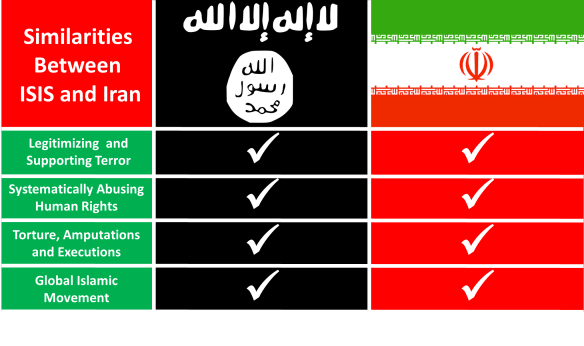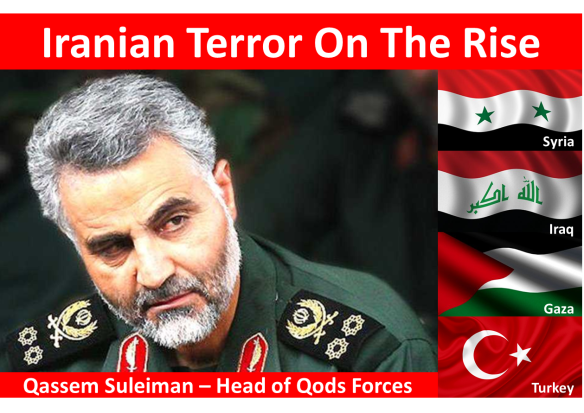
ISIS definitely took the world by surprise: here was a radical Islamic movement who made no apologies and didn’t cater to Western norms. The “spectacular” beheadings, the European jihadists, the fervent vision…all seemed so foreign to us.
But anyone who has been following the doings of ISIS’s Eastern neighbor and target shouldn’t have been too surprised. Why? Because, although there are some major differences between ISIS and the regime in Tehran, there are quite a few similarities as well.
ISIS & Tehran – fighting for Islam on a global scale
Both ISIS & Tehran are driven by a vision of global Islamization and a strict adherence to Sha’ariah law.
ISIS’s version of Islam is Sunni and is focused on Iraq/Syria for now but their call is for a global uprising of Muslims all over the world and a return to a purer form of Islam from the days of the Prophet.
In Iran’s Supreme Leader Khamenei’s vision of the long-awaited global “Islamic Awakening”, the world would turn away from Western capitalism and “embrace” Islam in order to bring about a “century of Islam“. Tehran’s focus on Islam is evident in its name (The Islamic Republic of Iran) and in the power of its Iranian Revolutionary Guard Corps (IRGC) which was established on the eve of the Islamic revolution in 1979 with the aim to “protect the country’s Islamic system“. Likewise, its vision of leading a global Islamic revolution with Tehran at its epicenter is exemplified by the elite Qods forces of the IRGC whose focus is in “extraterritorial operations” all over the world.
Bottom line – both hope for a global Islamic revolution but each hopes that it will lead it.
ISIS & Tehran – legitimizing the use of terror
Both ISIS & Tehran have no qualms in using terrorism in order to achieve their goals. This goes back to some of the most fundamental teaching of the Prophet who believed that terrorizing the enemy was a legitimate tool for the believers.
ISIS has perfected its version of terrorism to the world of social media by turning its acts of terror into spectacles that feed the curiosity of billions who, although disgusted by what they see, continue to look.
Iran’s version of terrorism is just as harsh but Tehran goes to great lengths to distance itself from the acts of terror themselves quite simply because supporting terror openly is not good for business with the West. This means that someone else usually does the dirty work for Tehran. Terrorist organizations such as Hezbollah, Hamas, Islamic Jihad etc… are supported financially, supplied militarily and trained by Iran.
Without Iran’s support, these organizations would simply dwindle away unless they found support from elsewhere. They are the ones responsible for some of the biggest massacres in Syria, bombarding Israeli cities from Gaza, acts of terrorism in Europe, Asia, North America, South America and Africa and much more.
Bottom line – both freely use terror but Tehran prefers to use proxy terrorists in order to preserve a “clean” image.
ISIS & Tehran – abusing human rights
Both ISIS and Tehran believe that Shaa’riah law supersedes any form of human rights in the eyes of the West. This may be hard to swallow in the West but it sometimes is much harder to live through on the inside where people are persecuted, tortured, imprisoned and killed because of their gender, their religion, their sexual preferences, their beliefs etc…
The gruesome trail of blood following the ISIS gangs is its message to all those they haven’t reached yet: either accept wholly our vision of Islam or else…
The regime in Tehran has mixed feelings about displaying abuses of human rights. They might agree with ISIS’s manner of enforcing Islamic law but they understand full well that abusing human rights openly, like promoting terrorism, is not good for business. Human rights are being abused in Iran constantly: floggings, torture, imprisonment and executions are experienced by anyone who doesn’t toe the line – women who are sick of gender inequality, gays who want to stop hiding, people who want to eat on Ramadan, Christians and Baha’is who want to practice their faith, politicians and activists who want to change the system, journalists and bloggers who hope for freedom of speech etc…
But, and this is a big “but”, all this is usually done under a heavy blanket of secrecy and denials in order to minimize criticism by the West which could subsequently empower enough Iranians to try to revolt against the regime.
Bottom line – both abuse human rights but Tehran prefers to keep its abuses hidden as much as possible from public scrutiny.
Obviously, ISIS is not Tehran and Tehran isn’t ISIS. One is a Sunni stateless organization with a total disregard to the expectations of Western states and the other is a Shi’ite state trying to foster relationships with Western states. But they do have more in common than friends of Tehran in the West would like to admit. Something to think about in regards to the role of Iran in the fight against ISIS and threats to the West once ISIS is eradicated.








